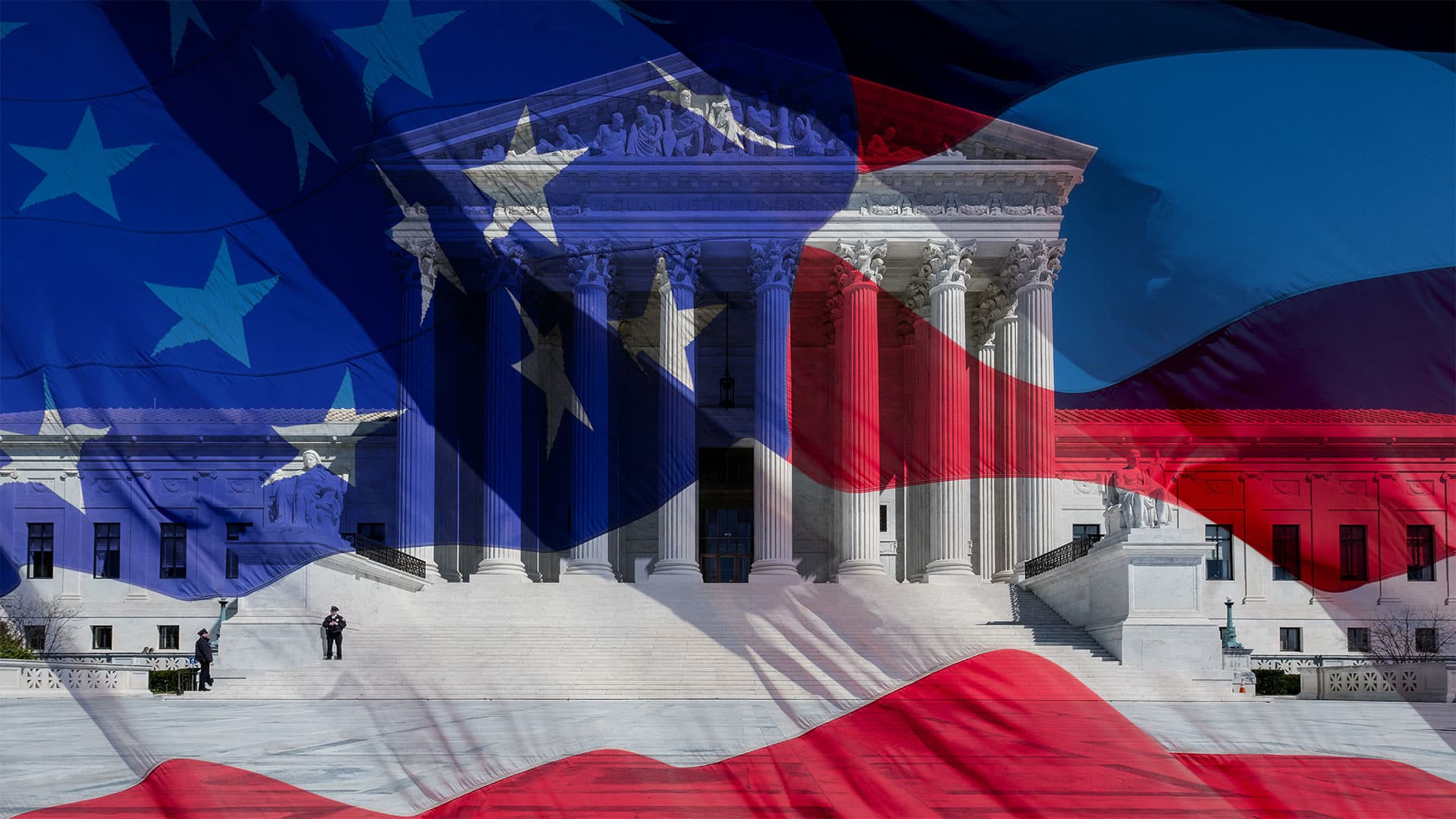
by Claire Anne Brule | June 24, 2022 | Abortion, News

On June 24, 2022, the U.S. Supreme Court overturned the case law decision of Roe vs. Wade which established constitutional federal protection for what has come to be called the “right to abortion.” The legal impact of this reversal means returning to the legal status which prevailed prior to Roe vs. Wade’s enactment in 1973. This means it will be up to each of the 50 states to legislate on abortion unless the US Congress passes a law at the federal level.
The Supreme Court’s decision rules on the constitutionality of a 2018 Mississippi state law https://law.justia.com/codes/mississippi/2018/title-41/chapter-41/gestational-age-act/section-41-41-191/ which sets abortion deadlines at 15 weeks of pregnancy, except for medical emergencies or severe fetal malformations. In December 2021, oral arguments were held for both sides: the Mississippi State Health Department represented by Thomas Dobbs, and the Jackson Women’s Health Organization, the only abortion clinic in the state of Mississippi.
Law or jurisprudence?
In many countries, including France, abortion is regulated by legislation voted by Parliament. In France, the Parliament recently extended abortion deadlines from 12 to 14 weeks of pregnancy. Alliance VITA’s website provides an analysis of the abortion laws in this country.
In the United States, the Congress, consisting of the Senate (100 seats) and the House of Representatives (435 seats), has yet to enact a legislation to forbid or restrict abortion.
Recently, the US Senate was unable to reach a majority vote for a bill passed by the House of Representatives. The bill was meant to codify the case law established by Roe v Wade and the 1992 decision in Planned Parenthood v Casey. The latter consolidated the 1973 Roe vs. Wade decision while simultaneously changing the criteria according to which a US state can regulate abortion
What Roe vs. Wade Stipulates
In Roe vs. Wade, the US Supreme Court ruled (7 – 2) that the U.S. Constitution protects a woman’s right to choose to have an abortion and specifies that unduly restrictive state regulation of abortion is unconstitutional.
“Jane Roe” is an alias name used by the plaintiff, Norma McCorvey, a Texas woman pregnant with her third child, and who wanted to abort in 1969. Henry Wade was the Dallas County District Attorney at that time when Texas law restricted abortion to life-threatening situations. The Roe v. Wade decision was reached according to two main legal elements.
The Supreme Court ruled that although it was not explicitly mentioned in the Constitution, a woman’s right to choose whether to have an abortion, could be considered to fall within the “right to privacy” under Section 1 of the 14th Amendment.
The Due Process Clause of the same amendment does not explicitly state that citizens have a right to privacy either. It specifies that “No state shall make or enforce any law which shall abridge the privileges or immunities of citizens of the United States; nor shall any state deprive any person of life, liberty, or property, without due process of law; nor deny to any person within its jurisdiction the equal protection of the laws. »
Adopted in 1868, this 14th amendment granted citizenship and equal civil and legal rights to all citizens, regardless of race or status (both to former slaves and free men).
In Roe vs. Wade, the Supreme Court ruled that the states could have a legitimate interest in restricting abortion including protecting the mother’s health and protecting the prenatal life of the fetus. To determine when the right to abortion would be without limitations, and when the state’s interests would be compelling enough to outweigh the woman’s right to choose, three standards of strict scrutiny were established:
- the burden of proof for invoking such limitations lies with the state,
- there must be “compelling state interest” in regulating abortions,
- and it should be pursued in the narrowest possible way”.
Since the right to have recourse to abortion was considered as a fundamental right, the laws governing it had to be assessed against these strict criteria.
In practice, the judgment used the criteria of the trimesters of pregnancy to decide whether the state’s law could be upheld. State law could not make any restrictions in the first trimester, but it would be possible during the second trimester. In the last trimester of pregnancy, possible state restrictions were based on health issues and medical emergencies for women.
Acknowledging the Viability Test, Planned parenthood vs. Casey.
In 1992, the Supreme Court adjusted the trimester framework, asserting what it considered as the 3 main conclusions of Roe vs. Wade:
- The mother has a constitutional right to abortion prior to the viability of the fetus, this right cannot be unduly interfered with by the state (known as “undue burden”).
- The state has the right to restrict abortion when the fetus is viable (“fetal viability”).
- The state has a legitimate compelling interest from the beginning of pregnancy to protect the mother’s health and the life of the fetus.
Previously, in other Supreme Court cases, one of the arguments invoked for hesitating to overturn Roe v Wade was the respect for precedent or “stare decisis“.
Analyzing state legislation according to the trimester-based framework was replaced in favor of a more flexible medical definition of “viability analysis”, offering the possibility of modifying the date of viability according to the medical knowledge.
Moreover, this judgment modified an important point since the criterion of strict conditions for analyzing state abortion laws legislation was replaced by “undue burden”. As a result, the ruling upheld the provisions of the Pennsylvania statute which required the pregnant woman or the parents of minors to sign an informed consent at least 24 hours prior to the act, although it negated the necessity for a woman to inform her partner.
Subsequent decisions rendered by the Supreme Court have further developed the concept of undue burden. In 2020, a Supreme Court decision June Medical Services LLC vs. Russo, reaffirmed that “many restrictions that did not impose a substantial obstacle were constitutional, while the restriction that imposed a substantial obstacle was unconstitutional.”
Conclusion
As evidenced by the number of various cases presented to the Supreme Court, the US state abortion laws have undergone many revisions since the initial vote of Roe vs Wade in 1973. Mississippi’s abortion law, the subject of the Court’s latest ruling, and the Texas “heartbeat” law voted in September 2021 are only two examples. In any case, it is difficult to compare abortion laws in the US to those in France since the legal systems are very different. Moreover, the US debate on abortion is still very fierce, with political standpoints resolutely divided into two camps. In France, as in the WHO, laws are continually being pushed in favor of extending abortion, therefore such discussions are more biased and challenging. Alliance VITA’s website recently analyzed the WHO’s ideological tactics to push abortion. Implementing a genuine abortion prevention policy for an act that is not trivial, that many women would prefer to avoid, is what is urgently needed.
For Alliance VITA any abortion is a personal tragedy and nothing to be celebrated. The Court’s decision to overturn Roe vs Wade should encourage each state to develop alternatives other than abortion with genuine abortion prevention policies and by offering support to pregnant women in need.

by Claire Anne Brule | June 17, 2022 | Euthanasia and Suicide, News, Palliative care

To mark the 20th anniversary of the law instituting palliative care, on June 14, 2022, three Palliative Care Federations in Belgium from Walloon, Brussels and Flanders joined forces to explain what palliative care is , and also to warn about the lack of access to palliative care.
“Palliative care… is all about life! ».
Healthcare professionals have chosen this catch phrase in order to warn about preconceived ideas and bad images associated with palliative care in Belgium, especially since their objective is specifically to attend to patients’ needs as diligently as possible.
In a joint statement these Palliative Care Federations point out that “Almost 100,000 patients per year are eligible for palliative care, although many do not have access.” Already in 2020, the federal evaluation commission highlighted this issue in their report by stating that “The number of beds in palliative care units must be quickly increased to meet patients’ needs, location and accessibility. The report also specified the need for funding “to cover the current costs of healthcare staff and to meet the costs for the services provided.” The evaluation commission also recommended that funding be allocated for psychologist positions in palliative care units.
Professionals lament that not enough emphasis is placed on the possibility of early care, which would considerably improve the quality of life for both patients and their loved ones.
The conditions for receiving the “palliative care package” are scheduled to be updated in 2023 by the Federal Center of Expertise for Healthcare in Belgium. The End-of-Life Care Research Group and others are already requesting that this financial aid package be extended to patients with a life expectancy of more than 3 years. Currently, this financial assistance to help cover the cost that palliative patients incur at home, (medicines, healthcare equipment and medical devices) is only granted under certain conditions, including:
- have an incurable disease;
- suffer a severely deteriorating physical or psychological condition;
- have a condition that no therapy can improve;
- have a life expectancy of less than 3 months;
- have physical, social and spiritual needs which require committing to a very elaborate set up;
- express a wish to die at home;
- and meet the conditions set out in the application form, known as “Medical Advice”.
The extension beyond three months would contribute to the quality of life for both the patient and his entourage, and consequently contribute to improving the current state of palliative care being provided.
“Hospitals often transfer patients to palliative care units when they can no longer do anything to cure the patient since they consider euthanasia to be a palliative care option, when, in my opinion, it is completely the opposite,” stated a caregiver in the book “Euthanasia, Behind the Scenes”, (Mols editions, published in 2019).
It would be interesting to survey the public and the caregivers in Belgium on how the legalization of euthanasia has affected the image of palliative care and how this may be creating confusion.

by Claire Anne Brule | June 10, 2022 | News, Surrogacy

It is a sad miscellaneous news item, such as the surrogacy business can produce. Social media got wind of the story via Cafemom which reported about a couple who renegated their surrogate baby. The news was first published by Reddit, but it was deleted due to the emotion and controversy it aroused.
In the United States, where surrogacy is tolerated in several states, an American couple signed an agreement with an agency to hire a surrogate mother. The couple donated gametes for in vitro fertilization, but when they came to meet and pick up the newborn, the father says he had the distinct impression “that something was wrong”. On discovering the baby’s face, they found it had Asian features. According to them, this little baby with brown eyes and black hair did not look like its’ parents since they are both blonde with blue eyes. They decided to have a DNA test made. The results of the DNA test confirmed that the man is not the biological father.
An investigation later revealed that the agency had inadvertently used the sperm of another man to conceive the child. The couple then explained in a message that they have decided not to keep the baby and to put him up for adoption. “It’s not a question of his ethnic origin, we are just upset that the baby is not ours. Even if he was white, but not our baby, we would have been just as angry. The surrogate mother was heartbroken too when she found out what happened, but she cannot afford to keep the baby because she already has five children.”
Alliance VITA contends that wherever surrogacy is legally tolerated, it creates unfair and inextricable situations. This is why Alliance VITA continues to call for an international ban on surrogacy.
For further information:
International Surrogacy [Video Replay] – Webinar “The reality of surrogacy” – Alliance VITA
https://www.alliancevita.org/2022/03/replay-la-realite-de-la-gpa/Analyzing so-called “ethical” surrogacy, VITA 2021

by Claire Anne Brule | June 9, 2022 | Human dignity, Human rights, News

Last March, Belgium voted to decriminalize prostitution. The new law is effective this month. Thus Belgium is the first country in Europe to pass such a law, and second in the world after New Zealand. The new clause for decriminalizing prostitution is included under a law dealing with sexual offences which was backed by the Federal Minister of Justice Vincent van Quickenborne, of the Flemish Liberal Party. Since prostitution was already tolerated in Belgium, the new law basically implies that third parties (bankers, renters) will no longer be penalized for transacting with prostitutes, “except in the event of abnormal profit”. The law also stipulates that prostitutes will now be eligible for social and health benefits granted for prostitution business. Pimping, on the other hand, remains prohibited. The reform also eliminates the charge of indecent assault which is replaced by the violation of sexual integrity. This is defined as “any act that a normal and reasonable person considers sexually inappropriate”. The law also broadens the scope for defining the instances of rape and increases the penalties and sentences to imprisonment, although it reduces the penalties for voyeurism.
The main arguments put forward by politicians or associations of prostitutes, include “providing a framework for an activity in a grey-zone”, “updating the law to match the current situation”, and even “criminalizing just creates no-rights’ zones.”
Germany’s Experience in Legalizing Prostitution
On the issue of supervising an existing activity and its potential benefits, one needs look no further than in Germany. In 2002, the Green party tabled legislative reforms which were approved by the federal Parliament to relinquish the general ban on promoting prostitution. This legalization was supervised and allowed employment contracts for prostitutes. The French Senator and former minister Laurence Rossignol pointed out that the demand for prostitution quadrupled in Germany over the 10 year-period from 2003 to 2013. As with free trade markets, an increase in demand is followed by an increase in supply. Thus, it doesn’t seem that the stated objective of combatting human trafficking was achieved by removing what the promotors of prostitution call the “no-go zones”.
In 2012, an https://papers.ssrn.com/sol3/papers.cfm?abstract_id=1986065 in-depth study of 150 countries concluded that legalizing prostitution increased human trafficking. According to the economists who made this study, the scale effect, that is a rise in demand, outweighs the substitution effect, which is supposed to increase the demand for legal prostitutes, thus reducing the demand for illegal prostitutes. “On average, countries where prostitution is legal, report larger human trafficking inflows.”
Human Dignity Is Not Compatible with Buying and Selling
Multiple and complex factors lead to prostitution. Belgium has opted for a neo-liberal approach of “laissez-faire” to supposedly adjust supply and demand, and magically solve the issue of illegal trafficking by legalizing prostitution.
This choice is opposed to the French law which sticks to an abolitionist approach. The April 13, 2016 law ruled that customers soliciting prostitutes be penalized, to “intensify the fight against prostitution and to support the prostitutes.” One of the main beliefs on which this law is founded is that the human body must not be treated as a mere commodity. Human dignity is simply not compatible with buying and selling. Criminalizing attacks against human dignity has nothing to do with facilitating human trafficking. It rather means having laws which fight against such violations.
![[Press Release] – Does Access to Abortion Foster Economic Growth ?](https://www.alliancevita.org/wp-content/uploads/2022/07/avortement-economie-1080x675.jpg)








